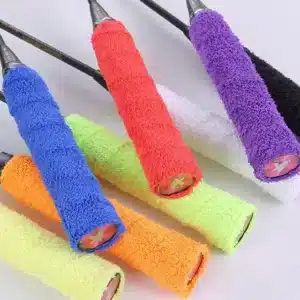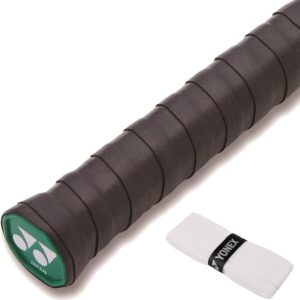The other day I was on court talking to a fellow player about preferences for the best badminton grip.
He shared how he preferred the towel grip as it gave him more confidence holding on to the racket during smashes and other strokes requiring a light touch before a firm squeeze.
It resonated with me as I had just found myself making several easy mistakes I normally wouldn’t make.
The shuttle would fly out of the court on an easy shot, I couldn’t block more than one shot in a row, and my smashes would constantly hit the net.
It drove me insane and I couldn’t figure out why this happened out of nowhere.
I slowly lost confidence and felt forced to play safer shots to avoid giving away free points. I felt stuck until it dawned on me that it had been a while since I changed my racket’s grip.
You’d think that the slippery feeling would be easy to notice, but when there are several things you aren’t great at, it can be hard to figure out which one is causing the issue.
After that game, I went off the court to apply a new grip and it instantly fixed the problem. I learned a valuable lesson: don’t forget to change your racket grip regularly!
Since your palm’s control of the racket is super important, finding the right handle grip is one of the rare instant wins we can get in badminton (as opposed to a new racket or strings that require you to adjust your technique).
There’s no single best badminton grip as each player’s hands are different, you’ll have to figure out what works best for you. To figure out if this is worth your energy, there are clues to look for.
For example, if you can’t keep up during fast drive duels all of a sudden (i.e. switching grip fast enough after the first shot is a challenge).
Or you don’t feel confident that the racket will stay in your hand during a full-power smash.
In this article, I’ll share my observations from experimenting with different handle grips, which grip is best for super sweaty hands, along with practical things like how often to change your grip and how to apply each type.
Table of Contents
The best badminton grips: observations from tests
While I will get around to doing a head-to-head test of the best badminton grips sooner or later, it’s one of the few items that are easy and affordable to test yourself to find the best fit specifically for you.
In fact, it might even change throughout your badminton ‘career’ like it has for me. I first began playing with towel grips, then switched to overgrips and felt they were better. Now I’ve switched to towel grips again as I’ve developed my technique and playing style.
I’ve found specific situations that happen often during my doubles games, like intense drive duels or defense, where I need to make sure I can swing my racket and switch between grips quickly without sweat getting in the way.
For fun, I switched the grip on one of my rackets back to the overgrip as I was preparing this article and did a quick head-to-head test against my usual towel grip during one of my sessions. But I had to give up on the overgrip after just a few games as the sticky feeling was completely gone due to sweat.
The biggest bang for your buck comes in figuring out which grip category you prefer (i.e. towel grip vs. overgrip), rather than the smaller nuances of each grip within the category.
Since you’ll need to restock regularly, trying a few options now and then is an affordable and easy way to hone in on your favorite (I change mine once monthly for example).
Many countries have unknown local brands making affordable grips that might be a better deal for you than, say, the standard Yonex grip in the same category.
Speaking of categories, there are three: replacement grip, overgrip, and towel grips.
| Racket Grip Category | Why Players Prefer This | Where To Apply |
|---|---|---|
| Replacement Grip | To adjust the handle size (i.e. to be thicker) | Instead of the standard factory grip |
| Overgrip | It's thin (you'll get a thinner handle) + grippy if you don't sweat much | On top of the standard factory grip |
| Towel Grip | Great at absorbing sweat | On top of the standard factory grip |
I haven’t tested replacement grips, so I can’t comment on those. Instead, let’s look at the best towel- and overgrips as they are the most popular.
I see two ways to look at the best grips:
- Use an affordable grip and change it more often
- Use a premium grip and change it less often
It comes down to your preference and how much the options cost where you live as you’ll usually be able to find several pricing tiers within the type of grip you like the most.
With that in mind, let me share the observations I’ve noticed from experimenting with different grips at different price tiers.
The best towel grips

I’ve played with a few dirt-cheap local variations from unknown brands (about $0.50-$1 a piece) and the difference was surprising even at this low price.
I noticed that the cheaper ones felt nicely soft like your bathroom towel before playing with them, but they had worse sweat absorption when I used them on court, especially after a few sessions. Almost as if they can handle a certain amount of sweat and after that, they can’t absorb or transport anymore away.
Others felt stiffer right out of the gate, but within just one game sweat loosened them up and they gave me more confidence to play with. It feels as if they can better handle more sweat while lasting more sessions.
Since sweat absorption tends to be the most important factor with towel grips, consider looking for the less soft and more stiff feeling ones if you can touch them at the store.
I found myself more inclined to buy the softer ones when feeling them out at the store, but on court, those that seemed stiffer worked better as they didn’t change as much after each session.
In my experience, there’s a major difference between the quality and pricing of towel grips, more so than with overgrips.
The best overgrips

I’ve found that the difference between overgrips is how tacky (sticky) they feel after the first game during each session and how well they transport or absorb the sweat. During the first use, they’ll feel great, but the question is how quickly the tackiness fades compared to how much you sweat.
In my experience, overgrips don’t ‘recover’ from sweat as fast between games as towel grips. I’ve found that even drying them off with a fan or towel between two games doesn’t help much, making the second game more difficult as your hands will slip more.
When you test the grips yourself, make sure to compare them after at least a few uses as that’ll best represent most of the sessions and games where we need it to help us on court.
I’ve played with different types of overgrips from several brands and found that the difference is often subtle and may be difficult to notice at first.
Badminton racket grip logistics
Let’s round this mini-guide off with a few suggestions about the logistics of your grip.
How often should you change the grip?
There is no fixed timeline for when you should change your grip but players who aren’t aware of the importance of a good grip tend to leave the same one on for far too long. I know I was guilty of that.
Changing it monthly (about 8-10 sessions for me) is a good place to start. You’ll benefit from taking note of when it gets slippery and you lose the effect, so change it according to that since it depends on the environment, sweating, how often you play, and the grip itself.
Other clues that it might be time to change your grip are:
- You hit overhead strokes out of the court more often than you normally would
- You struggle to change grip during fast midcourt exchanges or in defense to play a return you’re happy with
- You make lots of mistakes on strokes that you typically wouldn’t
I’ve had a great experience using two of the same rackets since I can switch between them when the grip gets too sweating during a session (you’ll realize just how big of a difference it makes when you can instantly get a nice dry grip).
The best badminton grip for sweaty hands
Most grips cater to sweaty hands since this is one of the main challenges we have with gripping the racket in general, so the question is how sweaty your hands get.
In the court I used to play at, my palms didn’t get that sweaty but at my current one it’s a lot warmer so I needed to make sure my grip catered to that.
Make sure you test out a few different grips to find what’s best suited for you in your current environment – a good place to start is by testing the towel grips or Yonex’s Super Tough Grip.
How to apply the grip
There are many different grips but the way we apply them is the same. Here’s a good walkthrough by former world champion Thomas Laybourn of Badminton Famly on how to apply Yonex’s Wet Super Grip.
Here’s CKYew applying a towel grip.
Takeaways
- The right grip is a giant benefit to your game. The trial and error to find the right one is well worth it
- We can’t depend on liking the same as our favorite player. We are different and play in a different environment
- Don’t underestimate how often you should change your grip to keep it effective
Frequently asked questions
There is no best grip since it’s based on your own preferences. Two options that are good to start experimenting with are the Yonex Towel Grip and the Yonex Wet Super Grip.
Viktor Axelsen uses the towel grip on his rackets to get the feel he needs, as you can see him describe here. In the example, he played with the Yonex towel grip in 2021.
Lin Dan has historically been using the towel grip like many other top players in the world. Most likely because its thickness fits well into his palm while providing the necessary sweat absorption. Tournaments in Asia tend to get particularly hot and so the hands might sweat more than, say, in the west.
There is no best grip size in badminton but the sizes G4 and G5 tend to be the most used these days.
The overgrip is a grip you place on top of the racket’s original grip to get a better feel between your palm and the racket when you play.
You’ll usually need to remove the old overgrip before applying a new one.
2 comments
I missed the point. What grip did you find out worked best for you, please?
Hey Martin, I’ve previously been playing with overgrips (I liked the Yonex Super Grip).
I’ve recently switched to the towel grip as they make the handle bigger which suits my hands better, and they feel gripper for longer. In my experience the overgrips are more grippy during the first few games, but doesn’t last long.